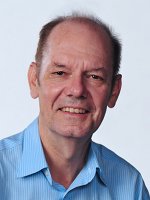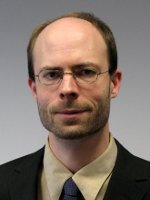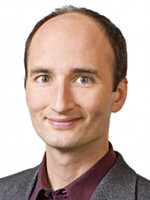
CGI 2013 - Keynote Speakers
CGI Keynotes
CGI: 30 years of key research in Computer Graphics
Prof. Daniel Thalmann, Nanyang Technological University, Singapore
CGI is the truly international conference in Computer Graphics since 30 years. Founded in 1983 by Professor Tosiyasu L. Kunii in Japan, the conference has not only disseminated the research in Computer Graphics in the five continents, but has shaped this research during 30 years in the areas of graphics modelling, rendering, animation, and more recently VR and internet-based graphics. In this talk, we will review the major steps in Computer Graphics during these 30 years based on key contributions presented in the CGI conferences. We will also survey the current status of the research in CG and open a window to the future.

Prof. Daniel Thalmann is with the Institute for Media Innovation at the Nanyang Technological University in Singapore. He is a pioneer in research on Virtual Humans. His current research interests include Real-time Virtual Humans in Virtual Reality, crowd simulation, and 3D Interaction. Daniel Thalmann has been the Founder of The Virtual Reality Lab (VRlab) at EPFL, Switzerland, Professor at The University of Montreal and Visiting Professor/ Researcher at CERN, University of Nebraska, University of Tokyo, and National University of Singapore. He is coeditor-in-chief of the Journal of Computer Animation and Virtual Worlds, and member of the editorial board of 6 other journals. Daniel Thalmann was member of numerous Program Committees, Program Chair and CoChair of several conferences including CGI, CASA, IEEE VR, ACM VRST, and ACM VRCAI. He is one of the founders of the Computer Graphics Society (CGS) and the International Society for Virtual Rehabilitation (ISVR). Daniel Thalmann has published more than 500 papers in Graphics, Animation, and Virtual Reality. He is coeditor of 30 books, and coauthor of several books including "Crowd Simulation" (2nd edition 2012) and "Stepping Into Virtual Reality" (2007), published by Springer. He received his PhD in Computer Science in 1977 from the University of Geneva and an Honorary Doctorate (Honoris Causa) from University Paul-Sabatier in Toulouse, France, in 2003. He also received the Eurographics Distinguished Career Award in 2010 and the 2012 Canadian Human Computer Communications Society Achievement Award.
Beyond geometry processing -
an effective calculus in the space of shapes
Prof. Martin Rumpf, Bonn University, Germany
The talk will introduce a geometric calculus on the space of shapes with
applications in geometry processing and in computer vision.
An effective time discretization enables the efficient solution of fundamental computing tasks such as
- shape morphing and the robust distance computation between shapes,
- extrapolation of surface animation beyond the animation time interval,
- natural transfer of geometric details from one graphical model onto another one,
- and a regression analysis of large geometry data bases.

Prof. Martin Rumpf studied Mathematics at Bonn University, graduating with the Diplom in 1989 and the PhD in 1992 on Analysis of
partial differential equations. Then, he was scientific assistant at the University of Freiburg and from 1996 until 2001 associate professor at Bonn.
From 2001 until 2004 he hold the chair for scientific computing at Duisburg-Essen university and since 2004 he is full professor for mathematics at Bonn
University. His research interests are at the interface of scientific computing, analysis, and geometry with applications in materials science, geometry processing,
and computer vision. A particular recent focus is on the geometry of the space of shapes, where investigations concerning physical modeling, convergence analysis of discrete models and efficient computation reflect the interplay of his different fields of interest.
Challenges in Interactive Mesh Modeling
Prof. Olga Sorkine, ETH Zurich, Switzerland
Irregular triangle meshes are a powerful digital shape representation: they are flexible and can represent virtually any complex shape; they are efficiently rendered by graphics hardware; they are the standard output of 3D acquisition and routinely used as input to simulation software. Yet irregular meshes are difficult to model and edit because they lack a higher-level control mechanism. In this talk, I will survey a series of research results on surface modeling with irregular meshes and show how high-quality shapes can be created and manipulated in a fast and intuitive manner. I will outline the current challenges in intelligent and more user-friendly modeling metaphors and will attempt to suggest possible directions for future work in this area.

Prof. Olga Sorkine is an Assistant Professor of Computer Science at ETH Zurich, where she leads the Interactive Geometry Lab at the Institute of Visual Computing. Prior to joining ETH she was an Assistant Professor at the Courant Institute of Mathematical Sciences, New York University (2008-2011). She earned her BSc in Mathematics and Computer Science and PhD in Computer Science from Tel Aviv University (2000, 2006). Following her studies, she received the Alexander von Humboldt Foundation Fellowship and spent two years as a postdoc at the Technical University of Berlin. Olga is interested in theoretical foundations and practical algorithms for digital content creation tasks, such as shape representation and editing, artistic modeling techniques, computer animation and digital image manipulation. She also works on fundamental problems in digital geometry processing, including parameterization, filtering and compression of geometric data. Olga received the EUROGRAPHICS Young Researcher Award (2008), the ACM SIGGRAPH Significant New Researcher Award (2011), the ERC Starting Grant (2012) and the ETH Latsis Prize (2012).
Bionics in Visual Computing:
From Physical Phenomena to Better Algorithms
From Physical Phenomena to Better Algorithms
Prof. Joachim Weickert, Saarland University, Germany
Most processes in nature can be described by relatively
simple laws, follow certain optimality principles, and
enjoy a number of invariances. Since these properties are
also desirable for most visual computing applications, it
is not surprising that nature has provided fascinating
inspirations for many algorithms. In this talk we will
explore three applications that have been developed in
our group and that rely heavily on ideas from nature:
We use simple principles from electrostatics to design
well-performing halftoning algorithms, and we show how
heat conduction can inspire novel methods for data
compression. Finally we generalise ideas from osmosis
in biology to design powerful methods for image editing.
All these algorithms are highly flexible and belong
qualitatively to the leading methods in their class.

Prof. Joachim Weickert is professor of Mathematics and Computer Science
at Saarland University (Saarbrücken, Germany), where he heads the
Mathematical Image Analysis Group. He graduated and obtained his Ph.D.
from the University of Kaiserslautern (Germany) in 1991 and 1996. He
worked as post-doctoral researcher at the University Hospital of
Utrecht (The Netherlands) and the University of Copenhagen (Denmark),
and as assistant professor at the University of Mannheim (Germany).
Joachim Weickert has developed many models and efficient algorithms for visual computing using partial differential equations and optimisation principles. In particular he has contributed to diffusion filtering, motion analysis in videos, processing of tensor fields, and data compression. His scientific work covers more than 250 refereed publications. They have been cited more than 12000 times and have led to an h-index of 54. Joachim Weickert has served in the editorial boards of nine international journals and is editor-in-chief of the Journal of Mathematical Imaging and Vision. In 2010 he has received the Gottfried Wilhelm Leibniz Prize which is the highest German science award.
Joachim Weickert has developed many models and efficient algorithms for visual computing using partial differential equations and optimisation principles. In particular he has contributed to diffusion filtering, motion analysis in videos, processing of tensor fields, and data compression. His scientific work covers more than 250 refereed publications. They have been cited more than 12000 times and have led to an h-index of 54. Joachim Weickert has served in the editorial boards of nine international journals and is editor-in-chief of the Journal of Mathematical Imaging and Vision. In 2010 he has received the Gottfried Wilhelm Leibniz Prize which is the highest German science award.
Small- and Large-Scale Dynamic Scene Analysis
Prof. Bodo Rosenhahn, Leibniz University Hanover, Germany
In this talk, we cover aspects on multiple object tracking and dynamic motion analysis using a detecting, trajectory estimation and classification framework.
We first present an overview of required and useful methods for object detection and trajectory generation, e.g. using graph matching or linear programming.
Our methods take into account all trajectories and all frames to solve the data association problem in a global optimization scheme.
Additionally, we include social and grouping behavior within the tracking
system. The obtained trajectories can further be classified with respect to specific activities by using an HMM-based classification.
We apply the methods on bacteria and pedestrian tracking given microscopic or surveillance camera data and show the general applicability of our developed methods.

Prof. Bodo Rosenhahn studied Computer Science (minor subject Medicine) at the University of Kiel. He received the Dipl.-Inf. and Dr.-Ing. from the University of Kiel in 1999 and 2003, respectively. From 10/2003 till 10/2005, he worked as PostDoc at the University of Auckland (New Zealand), funded with a scholarship from the German Research Foundation (DFG). In 11/2005-08/2008 he worked as senior researcher at the Max-Planck Insitute for Computer Science in Saarbruecken. Since 09/2008 he is Full Professor at the Leibniz-University of Hannover, heading a group on automated image interpretation. His works received several awards, including a DAGM-Prize 2002, Dr.-Ing. Siegfried Werth Prize 2003, DAGM-Main Prize 2005, IVCNZ best student paper award, DAGM-Main Prize 2007 and Olympus-Prize 2007. In 2011, the European Commission awarded Bodo Rosenhahn with a 1.43 million Euros ERC-Starting Grant. He published more than 100 research papers, journal articles and book chapters, edited several books and is holding several patents.
NASAGEM Workshop
Images from Surfaces
Prof. Marc Alexa, Technical University of Berlin, Germany
I describe several ways to create physically producible surfaces that display one, few, or continuous sets of prescribed images formed by different effects on the surface, such as diffuse reflection or self-occlusion. Especially the effect of showing different images for for different directions of light is surprising and not commonly seen in the real world. I explain theoretical limitations, measurements, and the different algorithms. The resulting surfaces have applications in entertainment, fabrication, and architecture.

Prof. Marc Alexa is a Professor in the Faculty of Electrical Engineering and Computer Science at the Technical University of Berlin and heads the Computer Graphics group. He is interested in creating, processing, and manufacturing shapes, as well as intuitive interfaces for these tasks. For his earlier work he received a Masters and PhD degree in Computer Science from Darmstadt University of Technology. He has been selected to chair the technical papers committee of SIGGRAPH 2013 and is a member of several international editorial boards and program committees. He received an ERC Starting Grant, the Heinz Meier-Leibnitz price, as well as other cross-disciplinary grants and awards.
Novel Algorithms for 3D Shape Analysis
Prof. Daniel Cremers, Technical University of Munich, Germany
With novel algorithms for 3D reconstruction from standard cameras,
range scanners or RGB-D cameras an increasing number of digitized
three-dimensional objects is becoming available. In my presentation,
I will introduce novel algorithms to analyze three-dimensional
shapes.
In the first part, I will introduce a novel algorithm to compute a dense elastic matching of shapes. More specifically, we propose to minimize an elastic thin-shell energy between two given 3D shapes by means of large-scale linear programming relaxations. In the second part, I will introduce the Wave Kernel Signature as a novel feature descriptor for shape analysis. It is defined as the time-averaged probability to detect quantum mechanical particles at respective points of the shape. In numerous experiments, I will show that it is well suited for various challenges of shape analysis ranging from correspondence finding and matching to shape decomposition.
In the first part, I will introduce a novel algorithm to compute a dense elastic matching of shapes. More specifically, we propose to minimize an elastic thin-shell energy between two given 3D shapes by means of large-scale linear programming relaxations. In the second part, I will introduce the Wave Kernel Signature as a novel feature descriptor for shape analysis. It is defined as the time-averaged probability to detect quantum mechanical particles at respective points of the shape. In numerous experiments, I will show that it is well suited for various challenges of shape analysis ranging from correspondence finding and matching to shape decomposition.

Prof. Daniel Cremers is a professor for Computer Science and Mathematics at
the Technical University of Munich. He received Bachelor degrees in
Mathematics (1994) and Physics (1994), and a Master's degree in
Theoretical Physics (1997) from the University of Heidelberg. In 2002
he obtained a PhD in Computer Science from the University of
Mannheim, Germany. Subsequently he spent two years as a postdoc at the
University of California at Los Angeles and one year as a permanent
researcher at Siemens Corporate Research (Princeton). From 2005 until
2009 he was associate professor at the University of Bonn, Germany.
Since 2009 he holds the chair for Computer Vision and Pattern
Recognition at the Technical University, Munich. His publications
received several awards, including the award of Best Paper of the
Year
2003 by the Int. Pattern Recognition Society and the 2005 UCLA
Chancellor's Award for Postdoctoral Research. In December 2010 the
magazine Capital listed Prof. Cremers among "Germany's Top 40
Researchers Below 40".